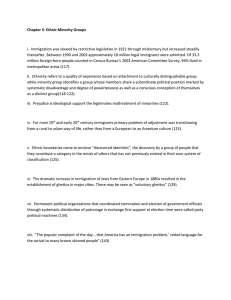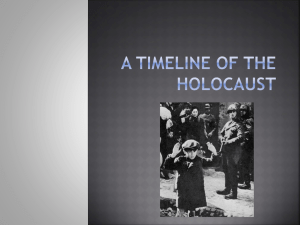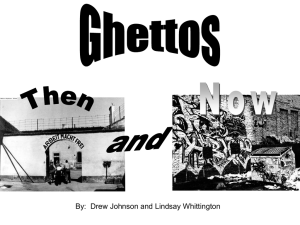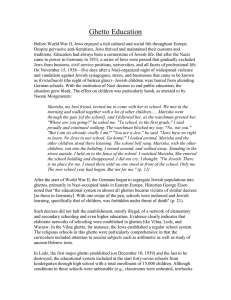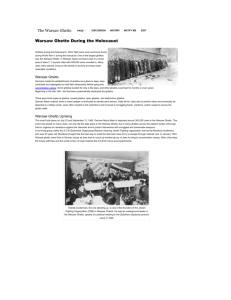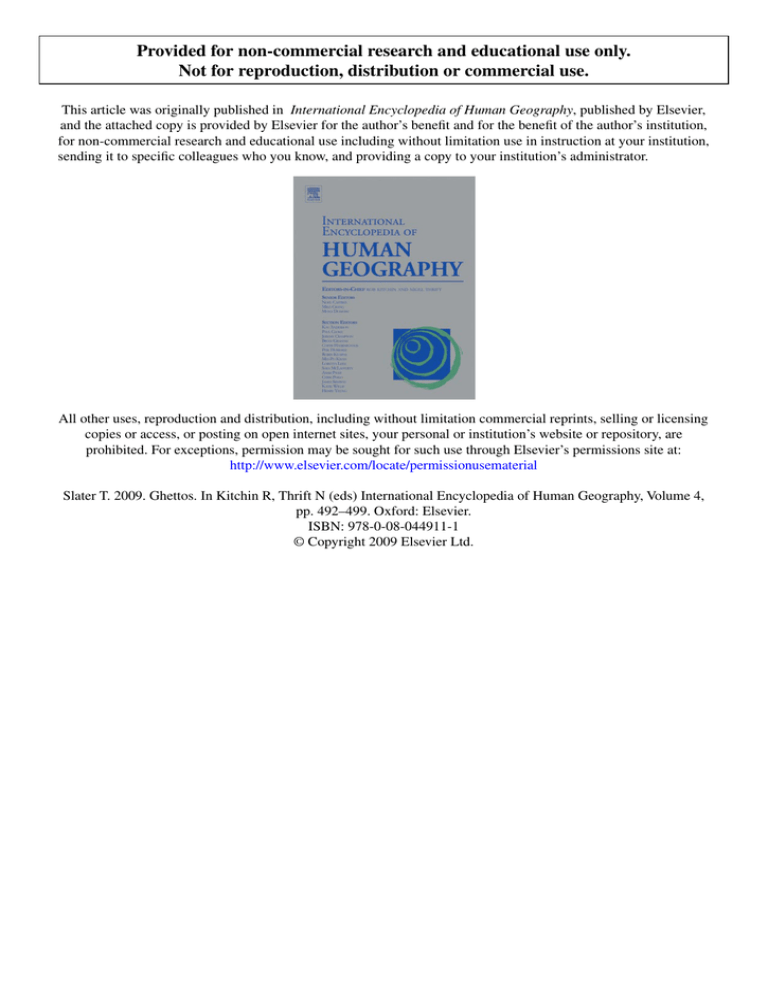
Provided for non-commercial research and educational use only.
Not for reproduction, distribution or commercial use.
This article was originally published in International Encyclopedia of Human Geography, published by Elsevier,
and the attached copy is provided by Elsevier for the author’s benefit and for the benefit of the author’s institution,
for non-commercial research and educational use including without limitation use in instruction at your institution,
sending it to specific colleagues who you know, and providing a copy to your institution’s administrator.
All other uses, reproduction and distribution, including without limitation commercial reprints, selling or licensing
copies or access, or posting on open internet sites, your personal or institution’s website or repository, are
prohibited. For exceptions, permission may be sought for such use through Elsevier’s permissions site at:
http://www.elsevier.com/locate/permissionusematerial
Slater T. 2009. Ghettos. In Kitchin R, Thrift N (eds) International Encyclopedia of Human Geography, Volume 4,
pp. 492–499. Oxford: Elsevier.
ISBN: 978-0-08-044911-1
© Copyright 2009 Elsevier Ltd.
Author's personal copy
Ghettos
T. Slater, University of Edinburgh, Edinburgh, UK
& 2009 Elsevier Ltd. All rights reserved.
Glossary
Apartheid A term meaning ‘separation’ in Afrikaans,
referring to a period in South Africa from 1948 to 93
when the ruling white supremacist National Party divided
the country into four racial groups and created separate
residential areas for each group along a distinct racial
hierarchy.
Assimilation The process of an ethnic minority group
acquiring the characteristics and sharing the resources
of the ‘host’ or majority group through residential
settlement patterns and/or behavior.
Banlieue The French word for ‘suburb’, it is now most
commonly applied to the declining working-class zones
of the French urban periphery housing relatively high
concentrations of ethnic minority residents.
Blockbusting A profiteering tactic deployed by
realtors or developers to convince white homeowners to
sell their houses by telling them that black people are
moving into their neighborhood, exploiting fears of
lowered property values. The price of the house is then
raised by the realtors when sold to black people.
Cités The French word to describe large estates of
cheaply built high-rises situated in the banlieues.
Ethnic Enclaves An urban settlement where the
dense clustering of one or many ethnic groups occurs, a
consequence of group solidarity, cultural affinity, kinship
ties, and occupational concentration, and usually
accompanied by economic and social activity tied to the
ethnicity of the group(s) in question.
Ethnoracial Group A group classified along the lines
of skin color, caste, culture, and/or religion.
Ghetto A space deployed by discriminatory authorities
to isolate, contain, and exploit a single ethnoracial
group; a place to cast out (permanently) a group outcast
from society.
Index of Isolation A measure of how often individuals
from a particular group are likely to meet other
individuals from their group – a group is ‘isolated’ if it
rarely comes into contact with different groups.
Index of Segregation A measure of the percentage of
a minority population which would have to change its
location in order to replicate the distribution of the rest of
the population of a city. It has a range of 0 (no
segregation) to 100 (total segregation).
Jim Crow A system of legally enforced racial
segregation (separate and inferior schools and
public spaces, along with separate churches and clubs)
in the southern states of the USA lasting from roughly
492
1865–1965. The term comes from a minstrel show
song-and-dance routine entitled Jumping Jim Crow.
Redlining A term coined in the late 1960s by
community activists in Chicago to describe the
government-initiated (in 1935) practice of marking a red
line on a map to delineate the area where banks would
not invest (especially through rejecting mortgage loan
applications). During the heyday of redlining these areas
were almost always black inner-city neighborhoods.
Segregation Either voluntary or involuntary, the
exclusion of a social group from the rest of society,
usually used in reference to spatial residential patterns,
but it can also relate to economic, social, and political
spheres.
Introduction
‘Ghetto’ is without question one of the most misunderstood and inappropriately deployed terms both within
and beyond geography and the social sciences. It is
regularly used (or abused) as a metaphor to describe the
spatial clustering of any social group (student ghetto,
immigrant ghetto), or indeed simply a dilapidated and/or
poverty-stricken urban area, rather than correctly used to
account for and analyze the selected few areas on the
planet that exhibit the involuntary spatial confinement of
a single ethnoracial group (in line with the history of the
term). It is also something of a surprise, perhaps even an
embarrassment to those who patrol the disciplinary walls
of geography, that the majority of the most widely read
and cited scholarship on ghettos – inherently geographical expressions of extreme racial oppression – has
come not from geographers but from sociologists. Furthermore, arguably the strongest and most famous studies
of ghettos tend to have in common their anchoring in
ethnographic methodologies – very few geographers researching the formation and social conditions of ghettos
have contributed to this tradition pioneered by the
Chicago School. The paucity of geographical research
that is accurately tuned in to the history of the term,
together with the qualitative geographical disengagement
and increasing confusion emanating from countless (and
rather numbing) indices of segregation/isolation, means
that analytical and policy errors toward marginal neighborhoods, whether ghettos or not, should come as little
surprise.
Author's personal copy
Ghettos
493
Origins: The Jewish Ghetto
Perhaps due to the power of stereotypical representations
of ghettos in the United States, and more recently the
rise of the ‘ghetto fabulous’ discourse, it is seldom acknowledged that the term ‘ghetto’ in fact comes from
Renaissance (sixteenth century) Venice. Following the
defeat of the Venetians by the French at Agnadello
(northern Italy) in 1509, Jews fled into Venice in increasing numbers, and quickly gained in social status via
the professions of, inter alia, moneylending and medicine.
Fledgling fear and hatred of Jews by the ruling Christians
was in part a consequence of a campaign for the moral
reform of the city following the weakening of its regional
power at the time. Jews were viewed by the Venetian
authorities to be the sole source of moral corruption, as
well as carriers of disease (the spread of syphilis was
incorrectly attributed to ‘overly sensual’ Jewish religious
practices, rather than to the growth of prostitution; and,
ironically, Jews making profits through usury was seen as
tantamount to prostitution, and thus disease). There were
widespread calls for the expulsion of all Jews to save the
city from further moral degeneracy and contamination,
but that would have been economic suicide for Venice,
which desperately needed the high taxes, rents, and skills
that the Jewish population provided. The solution of the
Senate of Venice was thus complete spatial segregation,
not expulsion: in 1516 all Jews were rounded up into an
abandoned foundry called ghetto nuovo (‘ghetto’ originally
meant ‘foundry’ in Italian) (see Figure 1). The ghetto was
surrounded on all sides by water, not unusual in Venice,
yet its walls were the highest in Venice, its outer windows
and doors permanently sealed, its two bridges to the rest
of the city guarded, and its surrounding canals patrolled
by police boat. Jews were allowed out into the city during
daylight hours only for economic reasons, but they had to
wear special yellow badges – the same color as the
scarves prostitutes were forced to wear. At dusk, Jews had
to return to the ghetto or face serious consequences. (It
remains something of a mystery why Shakespeare’s
Merchant of Venice, Shylock, moved with so much freedom
around the city!)
While oppression and violence toward Jews in Europe
did not begin in Renaissance Venice (ghettoization was in
fact a huge improvement on massacre, which happened
to Jews in medieval York under Henry II), the Venetian
Ghetto became a blueprint for cities throughout Europe.
The same fears about disease and moral upheaval, in
tandem with the same needs to retain and exploit a
Jewish population for its economic function, saw the
involuntary segregation of Jews in cities across the continent, as geographically distant as Rome, Frankfurt,
Prague, and Amsterdam. While they are often referred to
today as ‘Jewish Quarters’, historically they were ghettos
in both form and function. Yet while characterized by
Figure 1 Jacopo dei Barbari’s woodcut drawing of the Venetian
Ghetto, 1500. Reprinted from Sennett, R. (1994). Flesh and
Stone: The Body and the City in Western Civilization. New York:
Norton & Co.
intense overcrowding, squalor, disease, and deprivation,
they were also zones of collective consciousness, solidarity, and social organization. Because ghetto Jews were
subject to territorial confinement by night and overt racial ostracization during the day, Jewish culture and
community had no option but to develop in the densely
packed ghetto. The peculiar combination of spatial entrapment and social cohesion saw the emergence of
a ‘city within a city’, with its own institutions and administrative priorities. Everything from synagogues to
markets, from schools to charities formed and developed
behind ghetto walls, amplifying the rigid segregation of
the Jews from the rest of society, yet strengthening bonds
and kinship among ghetto dwellers, to the extent that
strong divisions between Ashkenazic and Shephardic
Jews collapsed in city after city under the experience of
complete and involuntary ethnoracial containment. If we
adhere to this historical fact – important if the ghetto is
to be correctly distinguished from other marginal spaces
that emerge from a different set of structural constraints
(requiring a different set of analytical lenses) – then the
ghetto can be defined as a space deployed by discriminatory authorities to isolate, contain, and exploit a single
ethnoracial group; a place to cast out (permanently) a
group outcast from society.
Transatlantic Connections: The AfricanAmerican Ghetto
From the late nineteenth century onward, as urbanization
accelerated in the cities of the north and eastern United
States (partly fuelled by immigration from Europe),
ethnic ‘clustering’ intensified as a consequence of group
solidarity, cultural affinity, kinship ties, and occupational
concentration. Three crucial factors distinguish the
Author's personal copy
Ghettos
famous (and most studied) example is the ‘Black Belt’ of
Chicago’s South Side (see Figure 2), the Bronzeville of
Drake and Cayton’s magisterial 1945 study, Black Metropolis, and an area that housed an almost all-black
population, and 92% of Chicago’s entire black population by 1930. Bronzeville is often the ‘dual definition’
marker used by many analysts to define a ghetto: almost
the entire population in the area was comprised of one
ethnic group, and almost every member of that ethnic
group in the entire city lived in that one area.
It must be noted here that, first, African-Americans
are the only group ever to experience urban ghettoization in the United States (a legacy of entrenched systems
of racial oppression, and of the white supremacy so ingrained in the power geometry of American capitalism);
and second, that the African-American ghetto has not
been consigned to history as a feature of the Fordist
metropolis, but is still a feature of the urban landscape in
city after city across the post-Fordist Rust Belt of the
United States. Following World War II, the color line
hardened even further due to the influence of federal
Zones of city growth
N
3 4
e lak
u s iv
igan
Mich
ke
a
L
E xc l
Zone I
‘The Loop’
Ex
cl
la
ve
u si
f
ke
t
r on
II −
eI
on
ne
ne
zo
Stock
yards
2
Miles
II −
Transition
Zone of working m
en
’s
on
e
Residential z
mmuter’s zone
− Co
−
IV
Zo
V
ne
Zo
s
me
ho
1
ont
e fr
0
Z
resultant ‘ethnic enclaves’ (Little Italies, Little Polands,
Little Irelands, etc.) from ghettos – first, they were not
products of ethnoracial control and containment by external overarching powers (one residential block in an
ethnic enclave often contained people of many different
nationalities); second, segregation within and between
them was neither extreme nor rigid; and third, they were
‘temporary’ spaces for the many thousands of European
immigrants residing in them, acting as springboards for
an assimilative leap into the American ‘melting pot’ once
plentiful opportunities for upward social mobility and
class ascension were captured (many ethnic enclaves
dissolved within two generations). A grave and terribly
influential error of the Chicago School of Sociology, an
extraordinary flowering of urban scholarship that drew
their inspiration from the natural sciences in order to
document the human-urban equivalent of animals
adapting to and competing in their natural habitats, was
to equate ghetto with ethnic enclave and predict that all
ethnic groups would assimilate into American society
after initial clustering in their ‘natural areas’. This was
not the experience for one group, African-Americans,
who from the early twentieth century migrated in massive numbers from the southern states to northern cities
for the twin reasons of fleeing Jim Crow racism and abject rural poverty, and for employment in the booming
factory-based industries of the north (where unskilled
labor was desperately needed to grease the engines of
Fordist capitalism).
The arrival of substantial numbers of blacks in
northern cities, just like the arrival of Jews in Venice four
centuries earlier, was seen by whites as a disturbing threat
to racial purity, the moral order of the time, and the
livelihoods of working-class whites employed in the same
industries. Blacks encountered harassment, hostility, and
violence from whites, strictly on the basis of the color of
their skins, together with a brutal tightening of previously porous systems of segregation in employment,
education, and especially housing. For a black person, to
cross the residential color line that emerged was to risk
serious physical harm inflicted upon them by whites who
had been socialized en masse into regarding blacks as
subhuman (a legacy of slavery). Furthermore, neighborhood organizations lobbied successfully to prevent blacks
from moving into white neighborhoods, while realtors set
in motion a profiteering process of ‘blockbusting’, thus
trapping African-Americans in overcrowded residential
areas where they quickly had to develop their own institutions to ensure the delivery of basic needs. This is
another clear parallel with the Jewish ghetto, another city
within a city, this time black within white, bounded by
the walls set up by racism smouldering at the core of
American society, and filtered through private and public
institutions that ensnared a group that was nonetheless
necessary for capitalist gain. Without question the most
Zon
e
494
Manufacturing
Areas over 50% Negro
Steel
mill
area
Figure 2 The location of Chicago’s ‘Black Belt’, 1945.
Reprinted from St. Drake, C. and Cayton, HR. (1993). Black
Metropolis: A Study of Negro Life in a Northern City (first publ.
1945). Chicago, IL: University of Chicago Press.
Author's personal copy
Ghettos
government initiatives in spurring rapid suburban expansion. Mortgage loans for white families led to what
became known as ‘white flight’ to the suburbs, and the
construction of highways enabled transportation between
downtown employment centers and the suburbs. The
problem of ghetto overcrowding was addressed by a
federally sponsored program of urban ‘renewal’, whereby
freeway construction ploughed through existing ghettos
and residents were relocated into vast public housing
projects invariably built alongside the freeways, effectively turning public housing into reservations for the
black urban poor, often termed ‘second ghettos’. For example, between the early 1950s and early 1960s, the
Chicago Housing Authority built 33 housing projects
comprising 21 000 units, 98% of which were built in
neighborhoods almost all black. Combined with the discriminatory practice of ‘redlining’, which made it impossible for black homeowners to sell up and leave
ghettos, systematic capital disinvestment amplified entrenched mechanisms of racial exclusion to ensure that
ghettos expanded and persisted, rather than dissolved
and eroded. It is therefore no surprise that the Kerner
Commission report of 1968, following the widespread
black uprisings or ‘ghetto riots’ of the 1960s (described by
Dr. Martin Luther King Jr. as the ‘‘language of the unheard’’), concluded that one factor above all underlay all
social and economic malaise – racial segregation.
One could be forgiven for assuming that the gains of
the Civil Rights Movement in the US led to the gradual
dismantling of the structural apparatus that had confined
African-Americans to ghettos, but ghettos persisted
through the 1970s and onward due to massive economic
restructuring and its effects on the poorest AfricanAmericans confined to ghettos. The major spatial impact
of Civil Rights and the abolition of overt racism within
housing markets (redlining was officially outlawed in
1977) was to facilitate the departure only of middle- and
lower-middle-class blacks from ghettos, leaving behind a
subproletariat lacking the political clout, the institutions,
the education, and the services required for upward
mobility. The advent of neoliberalism triggered the rapid
decline of manufacturing (and thus decent wage bluecollar employment), the suburbanization of alternative
employment, and the growth of the de-regulated lowwage service sector labor market (which offered no social
protection, unionization, or opportunities for promotion).
The outcome was the removal of the ability of young
black men able to support a family, so the number of
female-headed families grew exponentially at a time
when welfare payments were cut back, leading to deepening ‘feminized’ poverty on a staggering scale in economically traumatized cities such as Chicago, Cleveland,
Detroit, and Buffalo.
The contemporary post-Fordist African-American
ghetto is thus a different animal from its Fordist
495
predecessor in terms of social organization and structural
constitution. The neoliberal state has systematically dismantled the welfare state that allowed people to survive
outside the formal economy, and has replaced it with a
punitive ‘workfare’ state which coerces people into the
de-regulated low-wage labor market. Young black men
who either reject or are rejected by this labor market
often turn to the criminal economy in order to survive,
and thus come face to face with the increasingly punitive
arm of the neoliberal state (police, courts, jails, prisons),
which easily justifies its actions (mass incarceration) by
blaming the ‘underclass’ poor for not exercising ‘personal
responsibility’. This has led some scholars to argue very
convincingly that ghettos and prisons have become a
single, interconnected system for the punitive spatial
entrapment and management of the black urban poor.
Other Examples
Ghettos in the United States, then, while unique urban
phenomena in the Western Hemisphere, are not unprecedented – they are closely tied to the Jewish ghettos
of Europe in exhibiting the involuntary containment,
exploitation, and control of a single demonized group.
While ghettos in the accurate geographical, historical,
and sociological sense of the term are rare urban forms,
there are other zones of oppression and exclusion scattered throughout the world that can be termed ghettos.
The areas that contain Japan’s taboo Burakumin population, descendants of the country’s rural outcasts, are a
case in point. The premodern Tokugawa (or Edo) period
(1603–1868) saw the organization of Japanese society into
the four class categories of samurai, peasant, artisan, and
merchant. Below the merchant class were the outcast
groups of hinin, usually town guards, street cleaners, and
executioners; and eta, usually butchers, tanners, leather
makers, and undertakers. Hinin literally translates to
‘nonhuman’, while eta literally translates to ‘filthy’ – reflections of the attitudes held toward them (hinin/eta
villages were rarely printed on official maps). Unlike Jews
in European cities and blacks in American cities, the
descendant Burakumin were never an immigrant group,
yet they were widely perceived as a different race and
officially labeled outcasts by the Tokugawa government.
Burakumin were only permitted certain types of clothing,
not allowed to leave their burakus (rural hamlets) to enter
towns at night, and banned from entering Buddhist and
Shinto sites of meditation and worship. Rigid and total
segregation was enforced via strict rules controlling the
size of their houses and settlements, and even laws prohibiting their windows from facing tracks and roads.
As the Tokugowa era gave way to the Meiji period, in
1871 the Burakumin were emancipated, but akin to the
African-American experience this did not lead to simple
Author's personal copy
496
Ghettos
acceptance and assimilation into Japanese society. The
Burakumin became an increasingly urbanized population
and experienced new patterns of segregation through the
mechanisms of housing (Burakumin populations were
invariably forced into the poorest neighborhoods of
Japanese cities with the worst public services – Kyoto in
particular contains many segregated, poor Burakumin),
marriage (there was strict monitoring of family registration records to prevent marrying into other groups),
education (separate schools), and employment (they were
informally barred from industrial employment, and
forced to work traditional, low-paying, ‘unclean’ jobs).
Yet, in line with a chief characteristic of ghettos, to meet
their own needs the Burakumin developed their own
institutions replicating those of the society which had
excluded them, and organized efficiently to lobby for
urgent action to counter discrimination. While there have
been considerable gains in Burakumin rights since the
1960s, and evidence of desegregation in many cities and
villages, Burakumin ghettos still exist in tandem with the
discrimination that created them – while the latter may
be more subtle than in the past, continuing prejudice is
reflected in the resistance non-Burakumin children often
encounter from their parents when they wish to marry
Burakumin.
Another example of ghettoization which departs from
the textbook model but still exhibits the same organizing
principles is the townships of apartheid South Africa.
The white supremacist National Party came to power
there in 1948, viewing itself as ‘God’s chosen race’ to
‘civilize’ the southern tip of black Africa, despite the fact
that whites were massively outnumbered by black Africans in that country. Hendrik F. Verwoerd, Minister of
Native Affairs in the early 1950s and widely regarded as
the architect of apartheid (a word literally meaning
‘separation’ in Afrikaans), viewed complete and total
racial separation as the ‘answer’ to conflicting material
interests and cultures, to perpetuating white rule (via
economic control of vast mineral resources), and to reversing the decline of the white population. Shortly after
it came to power the government enforced the classification of South Africa’s population into four casually
defined but tightly policed racial groups, with a distinct
hierarchy – whites, Indians, ‘coloureds’ (mixed race), and
Africans (later ‘blacks’). In keeping with the accurate
meaning of the ghetto term, the National Party realized
that South Africa’s economy needed a vast supply of
cheap non-white labor, but also felt that under no circumstances should that labor live in city centers or
anywhere near desirable (white) areas. Therefore, they
legislated in de jure racial segregation to intensify, extend,
and cement in place the de facto segregation that already
existed, via the Group Areas Act (1950), called ‘‘one of
the cornerstones for preserving a white South Africa’’ by
Minister of the Interior, T. E. Donges that same year.
Between 1950 and 1993 it is estimated that over 1.5
million people were forcibly removed from their homes
under the Group Areas Act, and relocated to other parts
of South African cities, away from whites. ‘Group Areas’
(both business and residential) were ‘proclaimed’ by the
government for occupation/ownership by a specific racial
group, and persons of any other racial group became
‘disqualified’ persons who had to move out before a
government deadline (usually 3 months). This vast, brutal
system of social engineering through spatial manipulation led to the creation of vast township ghettos
involuntarily confining, exploiting, and controlling subordinated racialized groups, with devastating psychological, economic, and social consequences for displaced
persons. The legacy of the Group Areas Act is a highly
segregated urban landscape with millions of non-white
township dwellers living in grinding poverty, now amplified by the neoliberalization of South Africa, extreme
overcrowding via mass migration from all over sub-Saharan Africa, and the spreading AIDS pandemic. Townships, then, can accurately be termed ghettos, but they
are unusual in that they are relics of racist ‘minority’ rule
that sought to enclose a ‘majority’ population, and are
located inside cities systematically and ‘entirely partitioned’ along racial fault lines.
Case Study: The Myth of Contemporary
European Ghettos
It should be clear from the discussion above that not all
segregated areas are ghettos. Ghettos should be viewed as a
peculiar, extreme type of urban form rooted in discrimination toward a particular group of people loathed by their
oppressors, to the point where the oppressed are forced to
develop their own institutions behind the parameters of
their involuntary confinement to necessitate their survival.
To designate as ghettos any other segregated areas, such as
gated communities of affluent white suburbanites, residential concentrations of students in neighborhoods adjacent to
universities, or even the diverse neighborhoods of Western
cities themed along ethnic lines (‘Little Italy’ in Toronto;
‘Japantown’ in San Francisco; ‘Banglatown’ in London), is to
erase over 500 years of the term’s history and to begin any
analytical focus from an entirely inappropriate conceptual
point of departure. Yet time and time again, ‘ghetto’, a
morally loaded term carrying with it a set of pernicious
representations, is used incorrectly by scholars and especially by policymakers. Two recent examples from Britain
and France, reinforcing the myth that ghettos on a par with
African-American ghettos exist in European cities, serve to
illustrate problems of misuse.
The fear of nascent ghettos is a recurrent one in
Britain, but went into overdrive in September 2005, following a declamatory yet high-profile speech entitled
Author's personal copy
Ghettos
‘After 7/7: Sleepwalking to Segregation’ by Trevor
Phillips, then-Chair of the Commission for Racial
Equality (now the Commission for Equality and Human
Rights). Phillips argued that Britain has some residential
districts (in Bradford and Leicester) that are nearly as
segregated as Chicago’s South Side, and ‘‘are on their way
to becoming fully fledged ghettos – black holes into
which no-one goes without fear and trepidation, and
from which no-one ever escapes undamaged.’’ Not surprisingly the national media picked up on this part of the
speech and massaged it into a colossal moral panic about
the failures of multiculturalism, integration, community
cohesion, and immigration policy (Figure 3). However,
the speech was written without careful attention to the
2001 census, which revealed that there is not a single
administrative ward, let alone neighborhood, in Britain
in which the population is 90–100% ethnic minority,
whereas tracts with these percentages are commonplace
in the US. Furthermore, for all ethnic minority groups
identified by the census, indices of segregation in fact fell
between 1991 and 2001. If he did do much preliminary
reading, Phillips was most likely misled by research on
segregation using less reliable indices of isolation, which
did imply that Britain’s ethnic minorities were becoming
more isolated.
Regardless of what measures were consulted, however,
Phillips was painfully unaware that geographers have
been at the forefront of published research confirming
that Britain does not have ghettos. In Leicester, for example, the only city in which a segregation index rose
between 1991 and 2001 (from 30 to 39 for people of Black
Caribbean descent), local residential concentrations of
ethnic minorities are most definitely not a consequence
of the involuntary spatial containment and control of an
outcast single group that has since developed its own
Figure 3 Trevor Phillips, along with some of the headlines his
speech created. Reprinted from The Observer, 25 September
2005.
497
parallel institutions for survival. All ethnic minority
groups in that city and elsewhere remain heavily
dependent on the welfare state to supply basic needs, and
even if discrimination is present both in public and private institutions (such as in housing and employment),
Britain’s often ethnically diverse neighborhoods offer
no material for sensible comparison with the hostility
and systematic racial exclusion that historically and
geographically characterize rigid ghettoization. There are
two dangers of labeling as ghettos those British
neighborhoods that house a greater proportion of
ethnic minority groups than others. First, it creates
reputational ghettos, bogus territories that are nonetheless avoided through fear and damaged through
stigma, perpetuating the harmful discourse of ‘self-segregation’ and stirring up another myth, that of ethnic
withdrawal from society. Second, it obscures the increasing segregation that is happening in Britain – between rich and poor (not between white and non-white,
or between Christian and Muslim, for example) – and
deflects social policy attention away from class stratification/inequality and inappropriately toward fictitiously
broad racial divisions.
Britain is not the only country to experience ill-informed
policy-led ‘ghetto blasting’. French urban policy toward its
poorest neighborhoods has for some years now been guided
by the myth that the cités (housing projects) in the workingclass banlieues (suburbs) of its largest cities are very similar, if
not identical, to African-American ghettos in the United
States. A few weeks after Trevor Phillips’ speech was funnelled through hysterical national media in the UK, the
legend of structural and geographical equivalence between
the black American ghetto and the French urban periphery
was reinforced by the policy and media reaction to the major
civil disturbances that occurred in several banlieues in city
after city across France for a period of nearly 1 month. The
uprisings were a reaction to many months of severe police
oppression and harassment of marginalized first- and second-generation immigrant communities in those areas,
mostly from North and West African nations. On 27 October
2005, these ‘zero-tolerance’ surveillance tactics of then-Interior-Minister (and now President), Nicolas Sarkozy had
culminated in the death by accidental electrocution of two
teenagers trying to escape ‘routine’ police questioning in the
banlieue of Clichy-sous-Bois. In the weeks that followed, as
cars and buildings burned on the streets of urban France,
commentators and pundits quickly resuscitated long-running debates over immigration policy and the failures of
assimilation ideology, the tensions between Islam and the
secular policies of the French state, and in particular the
dilapidation and deepening misery of the cités, which in
demographic composition (large ethnic minority population), socioeconomic condition (crushing poverty and
widespread unemployment), and behavioral features (pandemic despair-cum-violence) were viewed to be the
Author's personal copy
498
Ghettos
European example of the American ghetto, as they have
been viewed for decades.
While the deterioration of living conditions and declining life chances in the French urban periphery
since the advent of the intertwined processes of postindustrialism and neoliberalism cannot be disputed, to
designate as race ghettos the cités and/or banlieues robs
these areas of an appropriate conceptual and analytical
framework that otherwise may go some way toward explaining their plight. Why, then, are they not ghettos, as
the respected source of BBC News repeatedly claims that
they are (see Figure 4)? Two crucial reasons (among
many) begin to explain why. First, a brief glimpse at
censuses of population, or even a few hours spent there,
will reveal that the population residing within them, just
like in many other ‘notorious neighborhoods’ in European cities, is characterized by remarkable ethnic heterogeneity, as opposed to the strictly enforced (from
without) ethnic homogeneity of ghettos. What unites the
marginalized urban population of France is (working)
class position, not racial subjugation via spatial entrapment. Second, residents in housing projects of suburban
France have regular contact with and dependency on
(through employment and consumption practices) residents of adjacent neighborhoods or those in the central
city. This was not the case in recent memory in Chicago’s
West Side ghetto, for instance, where so segregated and
contained were the residents of one housing project, the
Henry Horner Homes, that a young African-American
boy repeatedly asked his mother if all black people lived
in housing projects, and if all black people were poor.
With the possible exception of religious institutions, in
no cité or banlieue of (sub)urban France will a rigorous
analyst find evidence of a set of parallel institutions
forming to serve the basic needs of the excluded population – by contrast with what is common to all ghettos,
the same analyst will quickly discover that these are areas
where the tentacles of the welfare state, while shorter
than in previous decades, still stretch into and attempt to
assist lives of those for whom employment is precarious
or absent and opportunities for upward mobility limited
by language and skills.
Conclusion
Contrary to the powerful imagery associated with the
‘ghetto fabulous’ discourse, an attempt by hip-hop industry moguls in the United States to celebrate the triumph of those who have escaped ghetto poverty through
Figure 4 Urban legends are reinforced through inappropriate misuse of ‘ghetto’. Reprinted from the BBC News Website.
Author's personal copy
Ghettos
music and fashion (and now live lives of lavish consumption amidst ‘bling-bling’ Cristal champagne, expensive jewellery, and stretch limousines), ghettos are far
from fabulous, and instead should be viewed as tragic
urban forms that result from fear, oppression, and hatred.
If there is anything fabulous about ghetto life, it is the
extraordinary ability of their residents to form institutions of their own in the absence of external concern,
and to form strong communities that, contra the Chicago
School, are not ‘socially disorganized’ around the demonic imagery of the criminal ‘underclass’, but are organized in collective response to brutal confining forces
that seek to isolate yet exploit, and contain yet retain.
Reclaiming the ghetto term from inappropriate usage and
restoring it through direct linkage to its historical/geogaphical roots is vital if policies toward marginal neighborhoods are to be accurately formed and sensitively
implemented.
See also: Chicago School; Gay Geographies; Multicultural
City; Planning, Urban; Race; Redlining; Segregation;
Segregation Indices; Segregation, Urban; Slums;
Suburbanization; Underclass; Urban Morphology.
Further Reading
Anderson, E. (1978). A Place on the Corner. Chicago, IL: University of
Chicago Press.
Commission for Racial Equality (2005). Trevor Phillips’ speech, ‘After 7/
7: Sleepwalking to segregation’. http://83.137.212.42/sitearchive/
cre/Default.aspx.LocID-0hgnew07s.RefLocID0hg00900c002.Lang-EN.htm (accessed Jul. 2008).
Drake, S. and Cayton, H. (1993). Black Metropolis: A Study of Negro
Life in a Northern City (first publ. 1945). Chicago, IL: University of
Chicago Press.
Hane, M. (1982). Peasants, Rebels and Outcastes: The Underside of
Modern Japan. New York: Pantheon Books.
Hannerz, U. (1969). Soulside: Inquiries into Ghetto Culture and
Community. New York: Columbia University Press.
Hart, D. (1988). Political manipulation of urban space: The razing of
District Six, Cape Town. Urban Geography 9, 603--628.
499
Hirsch, A. (1998). Making the Second Ghetto: Race and Housing in
Chicago 1940–1960 (2nd edn.). Chicago, IL: University of Chicago
Press.
Johnston, R., Forrest, J. and Poulsen, M. (2002). Are there ethnic
enclaves/ghettos in English cities? Urban Studies 39, 591--618.
Kotlowitz, A. (1991). There are No Children Here: The Story of Two
Boys Growing up in the Other America. New York: Doubleday.
Ley, D. (1974). Association of American Geographers Monograph
Series, 7: The Black Inner City as Frontier Outpost: Images and
Behaviour in a Philadelphia Neighbourhood. Washington, DC:
Association of American Geographers.
Massey, D. and Denton, N. (1993). American Apartheid: Segregation
and the Making of the Underclass. Cambridge, MA: Harvard
University Press.
Peach, C. (1996). Does Britain have ghettos? Transactions of the
Institute of British Geographers NS 21, 216--235.
Philpott, T. (1978). The Slum and the Ghetto: Neighbourhood
Deterioration and Middle-Class Reform. Oxford: Oxford University
Press.
Sennett, R. (1994). Flesh and Stone: The Body and the City in Western
Civilization. New York: W.W. Norton & Co.
Wacquant, L. (1997). Three pernicious premises in the study of the
American ghetto. International Journal of Urban and Regional
Research 21, 341--353.
Wacquant, L. (2001). Deadly symbiosis: When ghetto and prison meet
and mesh. Punishment and Society 3, 95--134.
Wacquant, L. (2007). Urban Outcasts: A Comparative Sociology of
Advanced Marginality. Cambridge: Polity Press.
Western, J. (1996). Outcast Cape Town (2nd edn.). Berkeley, CA:
University of California Press.
Wilson, W. J. (1987). The Truly Disadvantaged: The Inner City, the
Underclass and Public Policy. Chicago, IL: University of Chicago
Press.
Relevant Websites
http://www.blhrri.org
Buraku Liberation and Human Rights Research Institute.
http://www.districtsix.co.za
District Six Museum, Cape Town: Documents and Explains the
Group Areas Act.
http://www.fcit.usf.edu
Excellent Photographs of the Venetian Ghetto, A Teachers Guide to
Holocaust, Florida Center for Instructional Technology.
http://www.urbandecay.ca
Remarkable Photographs of Chicago’s Ghetto Neighborhoods and
Public Housing Projects (Before They Were Knocked Down by the
Federal HOPE VI Program).
http://www.detroityes.com
The Fabulous Ruins of Detroit, DetroitYES.

